Efficacy of Virtual Reality in Painting Art Exhibitions Appreciation
Abstract
1. Introduction
1.1. Application of VR
1.2. Locomotion/Interaction in VR
1.3. Impact of Display Device on the Experience of Appreciation
1.4. Research Purpose
2. Materials and Methods
2.1. Paintings
2.2. Participants
2.3. Experimental Design
2.3.1. Independent Variables
Physical Painting Exhibition
Desktop Virtual Reality (Desktop VR)
Head-Mounted Display Virtual Reality (HMD VR)
2.3.2. Dependent Variables
2.4. Experiment Procedure
2.5. Statistical Analysis
3. Results and Discussion
3.1. Results of Descriptive Statistics and ANOVA Analysis
 on the upper right. Compared with HMD VR, the operation of Desktop VR was more intuitive. After logging in this web page, visitors could click the sign of the “white arrow” on the floor and they could move immediately to that place. They then could move the mouse to change the position of watching. Under each painting there was a quadrangle pattern, which could be clicked with the mouse to present the magnified image and the title of the work. However, with these two types of VR the painting size is fixed without being able to zoom in or out, and so viewers cannot zoom in the paintings at their will to appreciate the details. The above analysis tells us that the operation of the HMD VR in this experiment was imperfect. Apart from being able to watch from all directions, the operation of moving forward and backward should be improved. The more important one is to zoom in and zoom out the paintings. If these three functions and the intuitive interaction can be integrated into a single product, then the experience of watching through VR can be improved.
on the upper right. Compared with HMD VR, the operation of Desktop VR was more intuitive. After logging in this web page, visitors could click the sign of the “white arrow” on the floor and they could move immediately to that place. They then could move the mouse to change the position of watching. Under each painting there was a quadrangle pattern, which could be clicked with the mouse to present the magnified image and the title of the work. However, with these two types of VR the painting size is fixed without being able to zoom in or out, and so viewers cannot zoom in the paintings at their will to appreciate the details. The above analysis tells us that the operation of the HMD VR in this experiment was imperfect. Apart from being able to watch from all directions, the operation of moving forward and backward should be improved. The more important one is to zoom in and zoom out the paintings. If these three functions and the intuitive interaction can be integrated into a single product, then the experience of watching through VR can be improved.3.2. Correlations Between Measures
3.3. Three Favorite Paintings
4. Conclusions
Author Contributions
Funding
Acknowledgments
Conflicts of Interest
References
- Li, J.-C. Exploration of Strategies in Industrial Exhibition: Series Exhibition of Taiwan Telecommunications Industry as a Case Study. Technol. Mus. Rev. 2012, 16, 31–55. [Google Scholar]
- Burdea, G.; Coiffet, P. Virtual Reality Technology; Wiley-Interscience: New York, NY, USA, 1994. [Google Scholar]
- Chen, Y.-L. The Effects of Virtual Reality Learning Environment on Student Cognitive and Linguistic Development. Asia Pac. Educ. Res. 2016, 25, 637–646. [Google Scholar] [CrossRef]
- Yen, Y.-H. Creation and Research on Integrating Virtual Reality and Digital Game-Based Learning to Improve Learning Motivation—A Case Study of Periodic Table; National Taipei University of Technology: Taipei City, Taiwan, 2017. [Google Scholar]
- Ainge, D.J. Upper Primary Students Constructing and Exploring Three Dimensional Shapes: A Comparison of Virtual Reality with Card Nets. J. Educ. Comput. Res. 1996, 14, 345–369. [Google Scholar] [CrossRef]
- McLellan, H. Virtual reality and multiple intelligences: Potentials for higher education. J. Comput. High. Educ. 1994, 5, 33–66. [Google Scholar] [CrossRef]
- Winn, W.; Bricken, W. Designing virtual worlds for use in mathematics education: The example of experimental algebra. Educ. Technol. 1992, 32, 12–19. [Google Scholar]
- Riva, G. Virtual reality: An experiential tool for clinical psychology. Br. J. Guid. Couns. 2009, 37, 337–345. [Google Scholar] [CrossRef]
- Rose, T.; Nam, C.S.; Chen, K.B. Immersion of virtual reality for rehabilitation—Review. Appl. Ergon. 2018, 69, 153–161. [Google Scholar] [CrossRef]
- Tsai, T.-Y. A Study of Appling Interactive Virtual Reality to Tourism Experience Marketing; National Taipei University of Technology: Taipei City, Taiwan, 2016. [Google Scholar]
- Hsieh, M.-C.; Lin, Y.-H. VR and AR Applications in Medical Practice and Education. J. Nurs. 2017, 64, 12–18. [Google Scholar]
- Pietroni, E.; Pagano, A.; Rufa, C. The Etruscanning Project: Gesture-Based Interaction and User Experience in the Virtual Reconstruction of the Regolini-Galassi Tomb. In Proceedings of the 2013 Digital Heritage International Congress (DigitalHeritage), Marseille, France, 28 October–1 November 2013; pp. 653–660. [Google Scholar]
- Hsieh, Y.-L.; Chen, C.-H.; Lai, Y.-H. Inspiration and Creativity: Visitor Study of Virtual Reality-Based Museum Exhibition. Museol. Q. 2019, 33, 49–73. [Google Scholar]
- Gonizzi Barsanti, S.; Caruso, G.; Micoli, L.L.; Covarrubias Rodriguez, M.; Guidi, G. 3D Visualization of Cultural Heritage Artefacts with Virtual Reality Devices. In 25th International CIPA Symposium; Copernicus Gesellschaft mbH: Göttingen, Germany, 2015. [Google Scholar]
- Truschzinski, M.; Betella, A.; Brunnett, G.; Verschure, P.F.M.J. Emotional and cognitive influences in air traffic controller tasks: An investigation using a virtual environment? Appl. Ergon. 2018, 69, 1–9. [Google Scholar] [CrossRef]
- Alshaer, A.; Regenbrecht, H.; O’Hare, D. Immersion factors affecting perception and behaviour in a virtual reality power wheelchair simulator. Appl. Ergon. 2017, 58, 1–12. [Google Scholar] [CrossRef] [PubMed]
- Deb, S.; Carruth, D.W.; Sween, R.; Strawderman, L.; Garrison, T.M. Efficacy of virtual reality in pedestrian safety research. Appl. Ergon. 2017, 65, 449–460. [Google Scholar] [CrossRef] [PubMed]
- Dascal, J.; Reid, M.; IsHak, W.W.; Spiegel, B.; Recacho, J.; Rosen, B.; Danovitch, I. Virtual Reality and Medical Inpatients: A Systematic Review of Randomized, Controlled Trials. Innov. Clin. Neurosci. 2017, 14, 14–21. [Google Scholar] [PubMed]
- Portalés, C.; Lerma, J.L.; Pérez, C. Photogrammetry and augmented reality for cultural heritage applications. Photogram. Rec. 2009, 24, 316–331. [Google Scholar] [CrossRef]
- Hernández, L.A.; Taibo, J.; Blanco, D.; Iglesias, J.A.; Seoane, A.; Jaspe, A.; López, R. Physically walking in digital spaces a virtual reality installation for exploration of historical heritage. Int. J. Arch. Comput. 2007, 5, 487–506. [Google Scholar] [CrossRef]
- Boletsis, C. The new era of virtual reality locomotion: A systematic literature review of techniques and a proposed typology. Multimodal Technol. Interact. 2017, 1, 24. [Google Scholar] [CrossRef]
- Buttussi, F.; Chittaro, L. Locomotion in Place in Virtual Reality: A Comparative Evaluation of Joystick, Teleport, and Leaning. IEEE Trans. Vis. Comput. Graph. 2019. [Google Scholar] [CrossRef]
- Bozgeyikli, E.; Raij, A.; Katkoori, S.; Dubey, R. Point & Teleport Locomotion Technique for Virtual Reality. In Proceedings of the 2016 Annual Symposium on Computer-Human Interaction in Play, Austin, TX, USA, 16 October 2016; pp. 205–216. [Google Scholar]
- Calandra, D.; Lamberti, F.; Migliorini, M. On the Usability of Consumer Locomotion Techniques in Serious Games: Comparing Arm Swinging, Treadmills and Walk-in-Place. In Proceedings of the 2019 IEEE 9th International Conference on Consumer Electronics (ICCE-Berlin), Berlin, Germany, 8–11 September 2019; pp. 348–352. [Google Scholar]
- Bozgeyikli, E.; Raij, A.; Katkoori, S.; Dubey, R. Locomotion in virtual reality for room scale tracked areas. Int. J. Hum. Comput. Stud. 2019, 122, 38–49. [Google Scholar] [CrossRef]
- Qian, Y.Y.; Teather, R.J. The Eyes Don’t Have it: An Empirical Comparison of Head-Based and Eye-Based Selection in Virtual Reality. In Proceedings of the 5th Symposium on Spatial User Interaction, Brighton, UK, 16–17 October 2017; pp. 91–98. [Google Scholar]
- Blattgerste, J.; Renner, P.; Pfeiffer, T. Advantages of Eye-Gaze Over Head-Gaze-Based Selection in Virtual and Augmented Reality Under Varying Field of Views. In Proceedings of the Workshop on Communication by Gaze Interaction, Warsaw, Poland, 15 June 2018. [Google Scholar]
- Thomas, W.A.; Carey, S. Actual/Virtual Visits: What Are The Links? In Proceedings of the International Conference of Museums and the Web, Vancouver, BC, USA, 18–21 April 2018. [Google Scholar]
- Chen, J.-L.; Chen, S.-J.; Lin, C.-L. The Impact of an Actual Visit and Photograph Watching of an Exhibition on Visitor Viewing Experience. In Cross-Cultural Design. Cultural Differences in Everyday Life, Proceedings of the 5th International Conference, CCD 2013, Held as Part of HCI International 2013, Las Vegas, NV, USA, 21–26 July 2013; Rau, P.L.P., Ed.; Springer: Berlin/Heidelberg, Germany, 2013; pp. 269–278. [Google Scholar]
- Horn, M.S.; Solovey, E.T.; Crouser, R.J.; Jacob, R.J.K. Comparing the Use of Tangible and Graphical Programming Languages for Informal Science Education. In Proceedings of the SIGCHI Conference on Human Factors in Computing Systems, Boston, MA, USA, 13–17 April 1986; pp. 975–984. [Google Scholar]
- Yang, L.-Y. The Influence of Digital Technology on Aesthetic Visual Perception: A Case Study of Digital Images of Art Works in National Palace Museum; Taipei National University of the Arts: Taipei City, Taiwan, 2011. [Google Scholar]
- Antonietti, A.; Cantoia, M. To see a painting versus to walk in a painting: An experiment on sense-making through virtual reality. Comput. Educ. 2000, 34, 213–223. [Google Scholar] [CrossRef]
- Usui, S.; Sato, K.; Horita, T. Prototyping and Evaluation of Display Media using VR for Art Appreciation Education at School. Int. J. Learn. Technol. Learn. Environ. 2018, 1, 25–40. [Google Scholar]
- Yu, H.-K.; Lin, J.Q.-P. Level of Visitor Satisfaction with New Museum Interpretive Media Technology. Museol. Q. 2006, 20, 35–53. [Google Scholar]
- Hsu, Y.-H.; Chen, Y.-H.; Huang, Y.-H. An Inquiry on Interpretation Effects via Different Digital Exhibits in National Museum of Marine Biology and Aquarium: A Case of the “Ancient Ocean Gallery”. Technol. Mus. Rev. 2014, 18, 5–37. [Google Scholar]
- Higuera-Trujillo, J.L.; López-Tarruella Maldonado, J.; Llinares Millán, C. Psychological and physiological human responses to simulated and real environments: A comparison between Photographs, 360° Panoramas, and Virtual Reality. Appl. Ergon. 2017, 65, 398–409. [Google Scholar] [CrossRef] [PubMed]
- Zhang, K.; Suo, J.; Chen, J.; Liu, X.; Gao, L. Design and Implementation of Fire Safety Education System on Campus Based on Virtual Reality Technology. In Proceedings of the 2017 Federated Conference on Computer Science and Information Systems (FedCSIS), Prague, Czech Republic, 3–6 September 2017; pp. 1297–1300. [Google Scholar]
- Mittelstaedt, J.; Wacker, J.; Stelling, D. Effects of display type and motion control on cybersickness in a virtual bike simulator. Displays 2018, 51, 43–50. [Google Scholar] [CrossRef]
- Sharpe, E.; Silva, J.D. Art’s most popular exhibition and museum visitor figures 2018. The Art Newspaper, 27 March 2019. [Google Scholar]
- Hazan, S. The Digital Exhibition—Considered in the Long Term. Uncommon Cult. 2015, 6, 12–19. [Google Scholar]
- Hsieh, H.Y. Taiwanese Version of the PAD Emotion Scales. In Proceedings of the 2011 Conference of Taiwan Institute of Kansei, Kaohsiung, Taiwan, 2 December 2011. [Google Scholar]
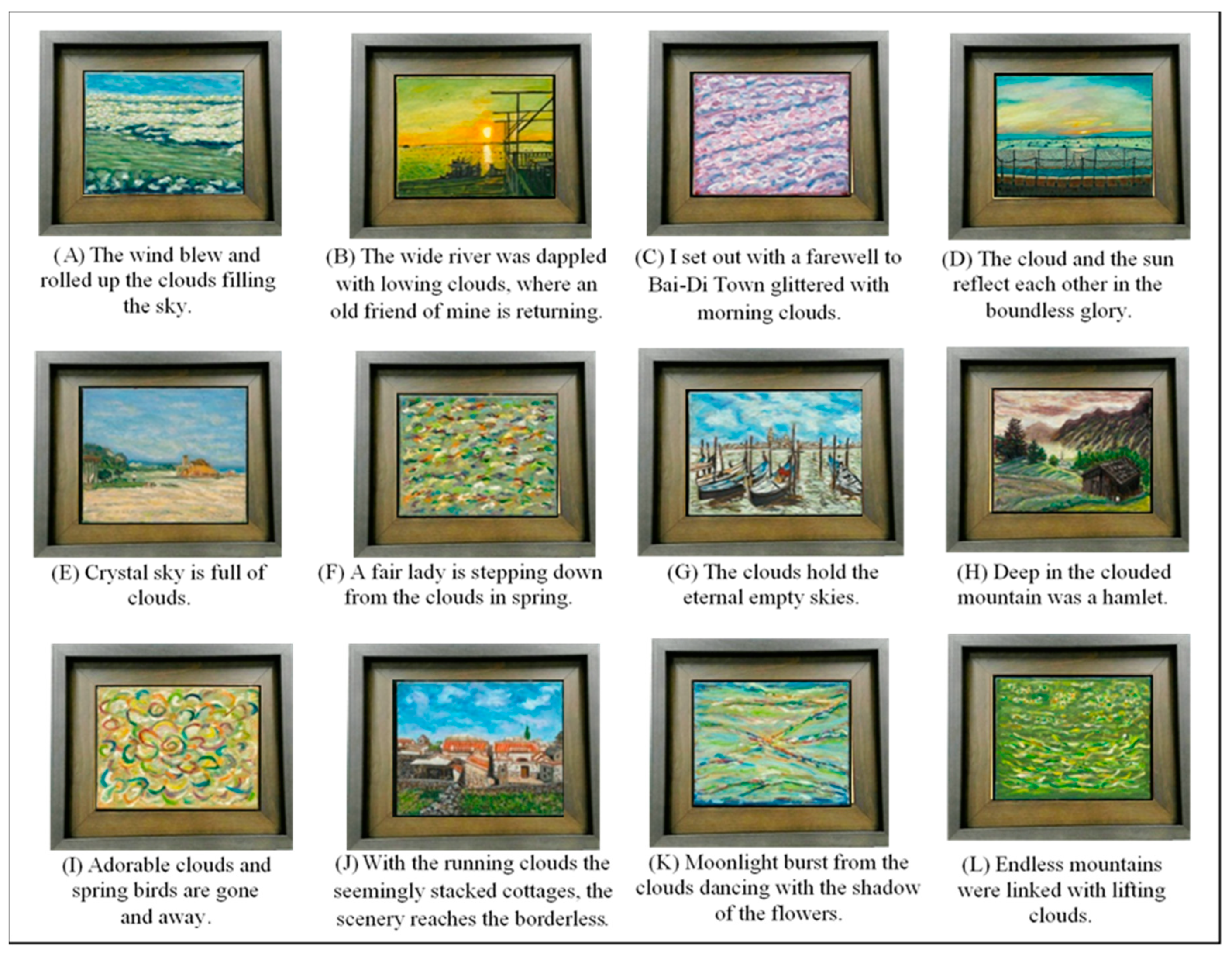
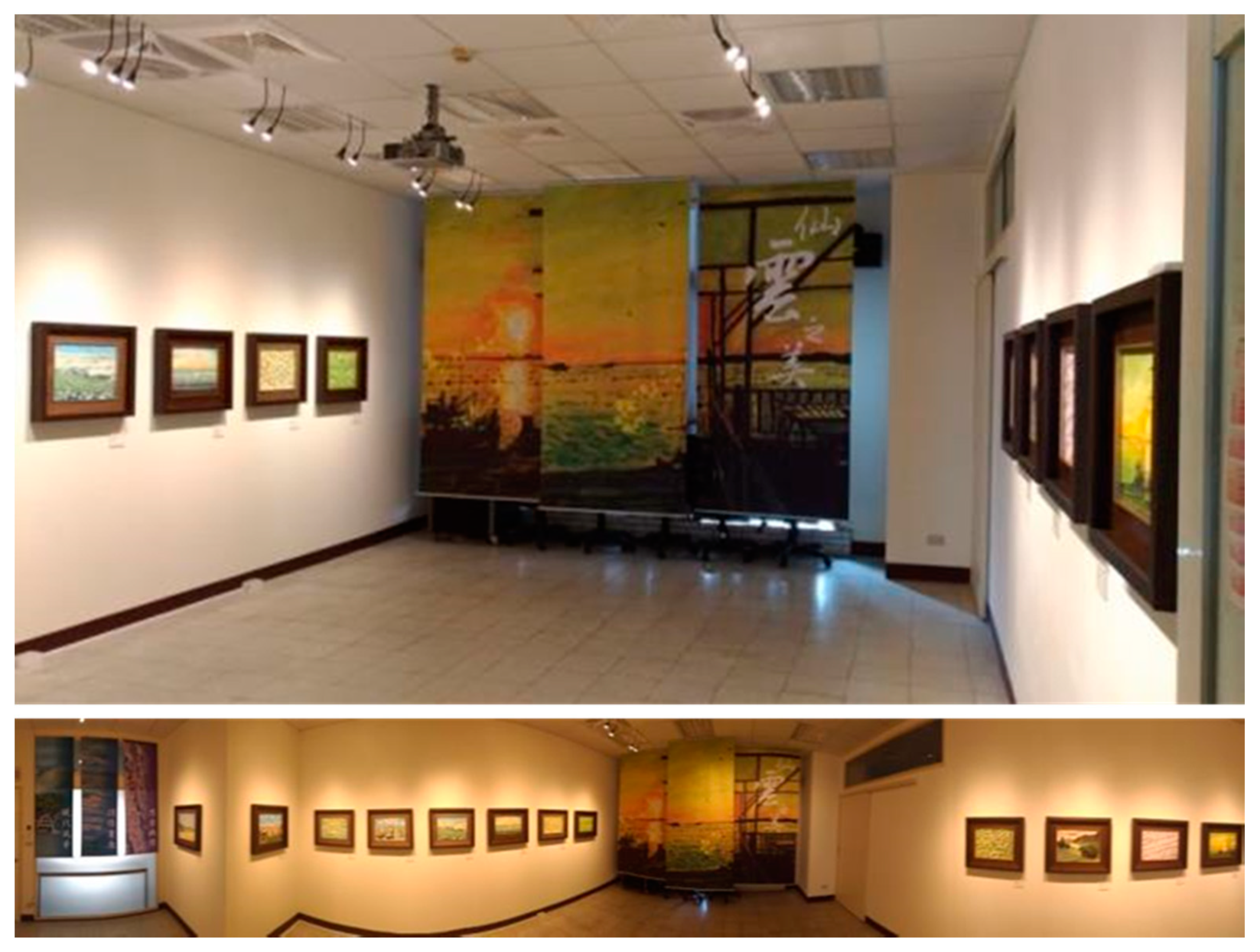
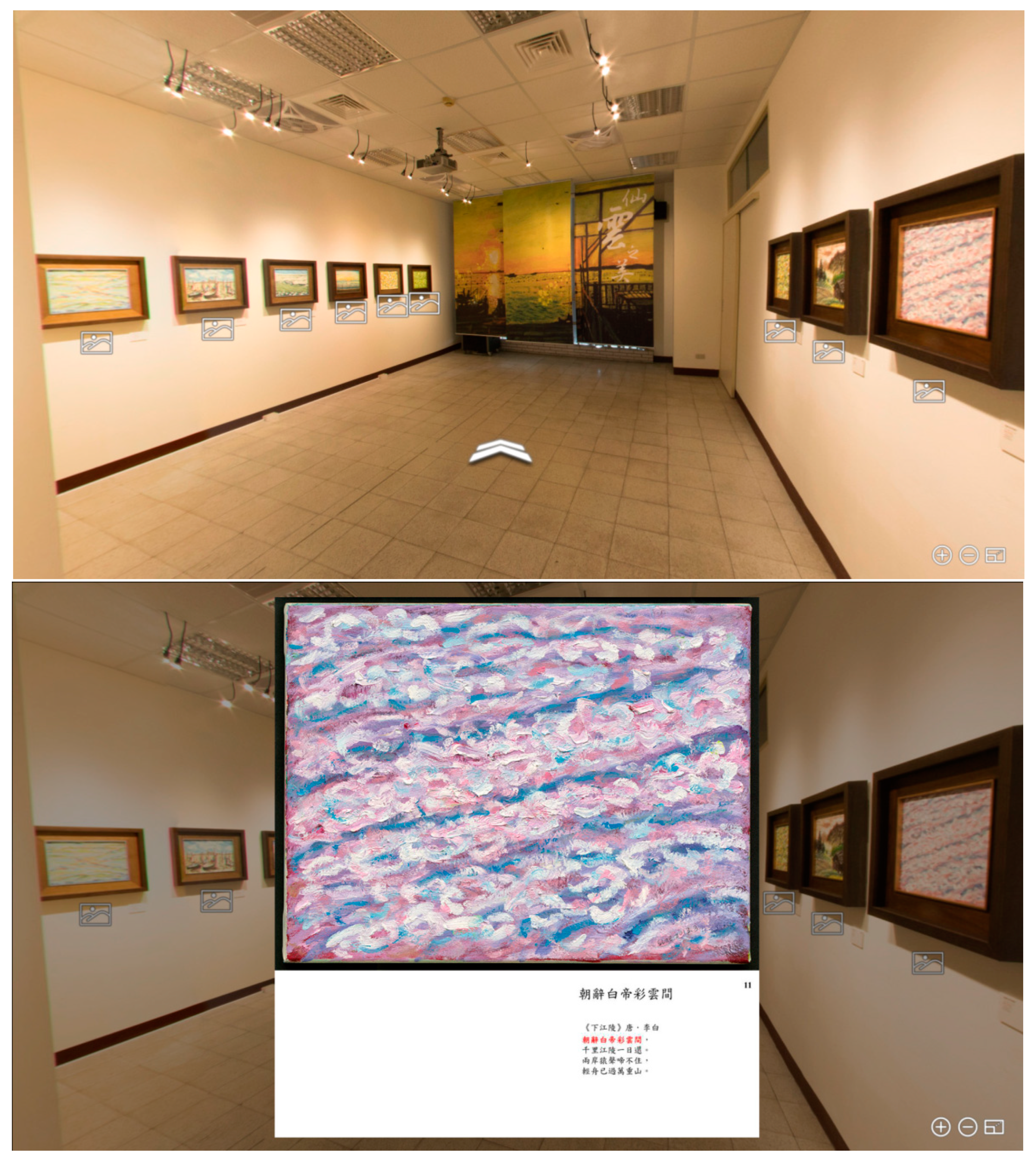
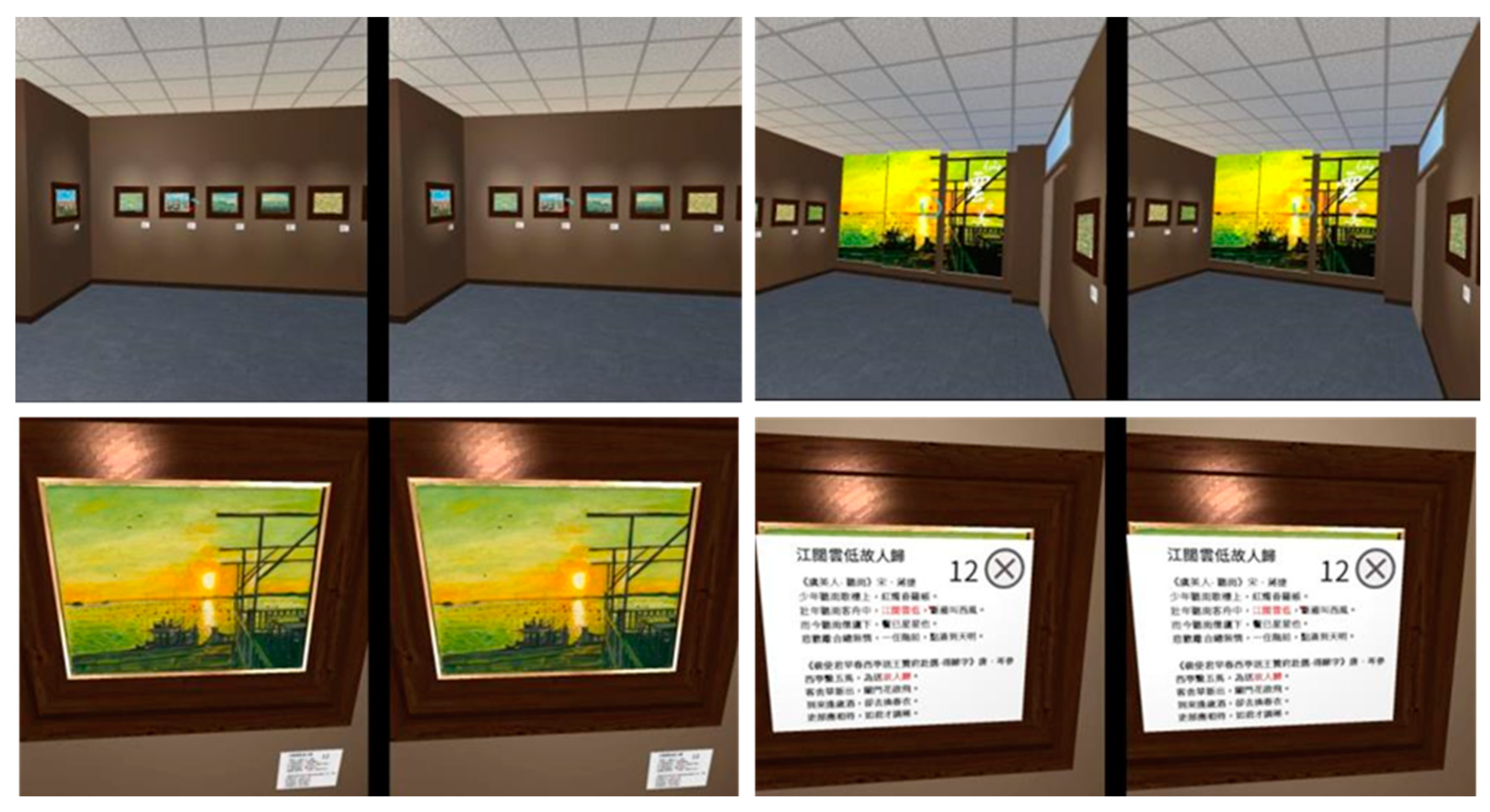
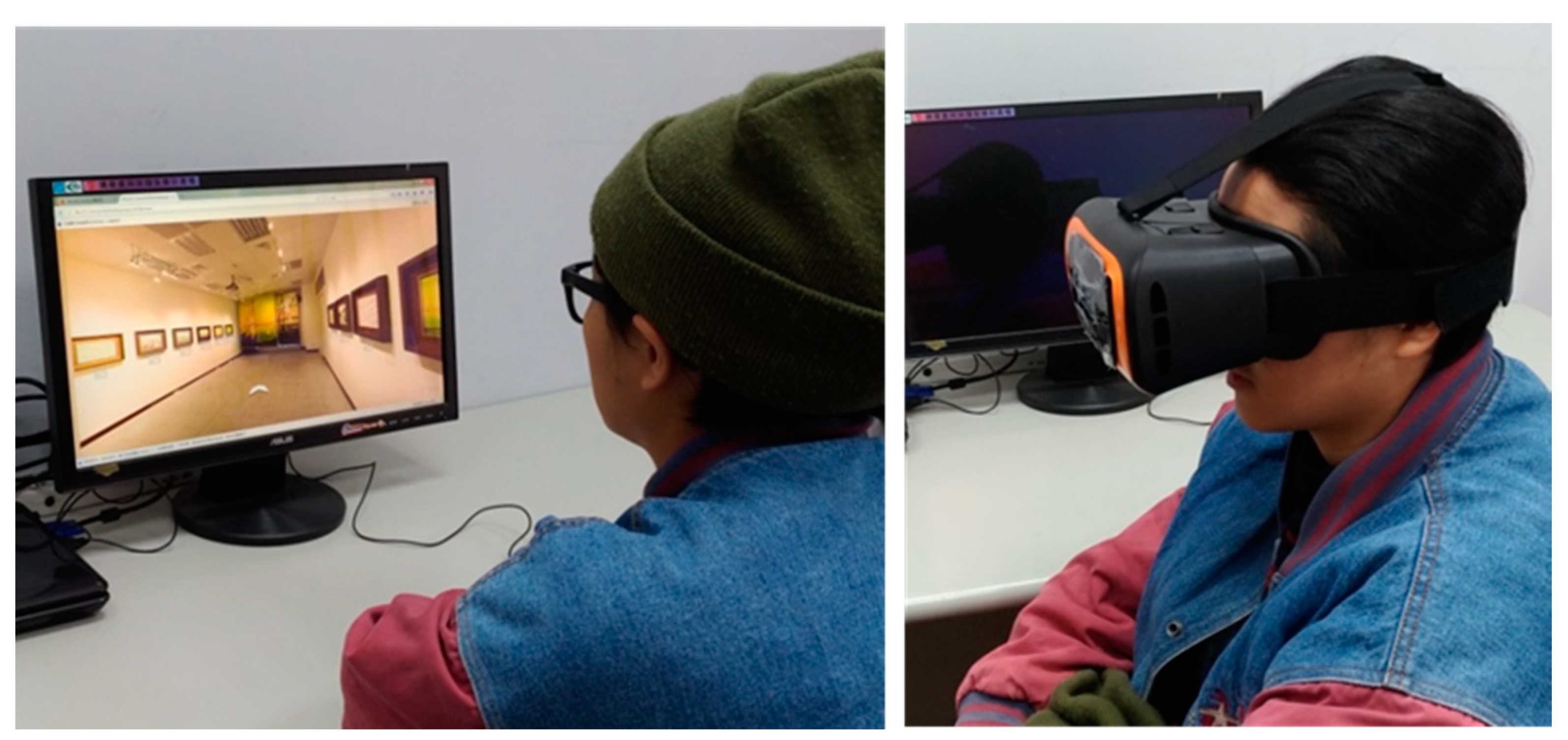

| Subjective Questionnaire ((1-5 points) | Media for Painting Exhibition | |||
|---|---|---|---|---|
| Physical Paintings | Desktop VR | HMD VR | Significance | |
| 1.Pleasure | 3.8 | 3.6 | 3.7 | |
| 2.Relaxed | 3.8 | 3.7 | 3.4 | |
| 3.Calm | 3.7 | 3.6 | 3.4 | |
| 4.Having access to all works I like | 4.4 b | 4.1 b | 3.4 a | *** |
| 5.Originality | 3.3 | 3.5 | 3.2 | |
| 6.Attractive | 3.1 | 3.3 | 3.1 | |
| 7.Precious | 3.2 | 3.4 | 3.1 | |
| 8.Meaning of cloud | 3.5 | 3.4 | 3.1 | |
| 9.Title encouragement | 3.6 a | 3.6 b | 3.1 a | * |
| 10.Hang it in my house | 3.0 | 3.1 | 2.9 | |
| 11.Preference | 3.1 | 3.3 | 3.2 | |
| 1 | 2 | 3 | 4 | 5 | 6 | 7 | 8 | 9 | 10 | 11 | |
|---|---|---|---|---|---|---|---|---|---|---|---|
| 1. Pleasure | 1 | ||||||||||
| 2. Relaxed | 0.69 *** | 1 | |||||||||
| 3. Calm | 0.51 *** | 0.84 *** | 1 | ||||||||
| 4. Having access to all works I like | 0.37 ** | 0.46 *** | 1 | ||||||||
| 5. Originality | 0.23 * | 0.29 * | 1 | ||||||||
| 6. Attractive | 0.24 * | 0.28 * | 0.30 ** | 0.25 * | 0.74 *** | 1 | |||||
| 7. Precious | 0.30 ** | 0.27 * | 0.57 *** | 0.66 *** | 1 | ||||||
| 8. Meaning of cloud | 0.36 ** | 0.29 * | 0.28 * | 0.45 *** | 0.47 *** | 0.54 *** | 1 | ||||
| 9. Title encouragement | 0.37 ** | 0.44 *** | 0.52 *** | 0.53 *** | 1 | ||||||
| 10. Hang it in my house | 0.32 ** | 0.38 ** | 0.37 ** | 0.55 *** | 0.52 *** | 1 | |||||
| 11. Preference | 0.25 * | 0.33 ** | 0.25 * | 0.46 ** | 0.43 *** | 0.36 ** | 0.48 *** | 0.52 *** | 0.45 *** | 1 |
© 2020 by the authors. Licensee MDPI, Basel, Switzerland. This article is an open access article distributed under the terms and conditions of the Creative Commons Attribution (CC BY) license (http://creativecommons.org/licenses/by/4.0/).
Share and Cite
Lin, C.-L.; Chen, S.-J.; Lin, R. Efficacy of Virtual Reality in Painting Art Exhibitions Appreciation. Appl. Sci. 2020, 10, 3012. https://doi.org/10.3390/app10093012
Lin C-L, Chen S-J, Lin R. Efficacy of Virtual Reality in Painting Art Exhibitions Appreciation. Applied Sciences. 2020; 10(9):3012. https://doi.org/10.3390/app10093012
Chicago/Turabian StyleLin, Chih-Long, Si-Jing Chen, and Rungtai Lin. 2020. "Efficacy of Virtual Reality in Painting Art Exhibitions Appreciation" Applied Sciences 10, no. 9: 3012. https://doi.org/10.3390/app10093012
APA StyleLin, C.-L., Chen, S.-J., & Lin, R. (2020). Efficacy of Virtual Reality in Painting Art Exhibitions Appreciation. Applied Sciences, 10(9), 3012. https://doi.org/10.3390/app10093012






